
MAY CONTAIN NUTS

Search Shorpy
SHORPY ART

Framed or unframed, desk size to sofa size, printed by us in Arizona and Alabama since 2007. Explore now.
Join and Share
Ad-Free Shorpy
Shorpy is funded by you. Patreon contributors get an ad-free experience.
Learn more.

Recent comments
- Side Winder
- Air Quality?
- Sojourner Truth riot
- None were so blind(ed)
- The less famous sister
- Good ol' days?
- Rise and Fall
- Goo Goo Ga Joob
- Ticket Retention
- Not the only one
- Vagaries of War
- Killed by Amtrak
- Back to the Future
- Wanted --
- If you can't stand the light
- Centralized Traffic Control, I believe
- What's really happening
- Heckuva remote control!
- Sometimes — Things Go Bump!
- I SEE THE LIGHT
- Union Switch and Signal Company
- Get That Light Out Of My Eyes
- Eggs. Eggs. Eggs. The Egg Man is Here!
- Foreboding caption
- Famous Hollywood faces
- Not just S&P
- re: Those things in the jar
- Up In Smoke
- Medical Smoking
- Quick fix
Member Photos
The Shorpy
Print Emporium
Print Emporium
Search Shorpy
Search results -- 30 results per page
- Arsenal of Democracy: 1941
- August 1941. Warren, Michigan. "Tank manufacture (Chrysler). These are partially completed M-3 ... Posted by Dave - 11/16/2020 - 4:55pm -
![Arsenal of Democracy: 1941 August 1941. Warren, Michigan. "Tank manufacture (Chrysler). These are partially completed M-3 tanks, 28-ton steel giants being turned out at the huge Chrysler tank arsenal near Detroit. The camera was directed toward the end of the three main assembly lines. Mass assembly methods developed in automobile manufacture are used. Note overhead cranes for heavy parts." Photo by Alfred Palmer for the Office for Emergency Management. View full size.
BookWhen I was younger, I found, in a used book store, a small book about the effort by an automotive manufacturer to build tanks for WWII. I believe it was actually published by the manufacturer to document their work after the war. Don't remember whether it was GM, Ford or Chrysler. But, it was a fascinating read, with pictures of the assembly process, at least one of them much like this one.
Previously on Shorpy --Quite a few Alfred Palmer 4x5 Kodachromes featuring M-3 crews training at Fort Knox have appeared on Shorpy. Here are a few:
M-3s in Action: 1942
Aim High: 1942
Fort Knox: 1942
Hits the SpotLooks like a very thrifty operation indeed, at least if judged by the recycled Pepsi-Cola bucket sitting on the floor just ahead of the stand-mounted engine at lower right.
M-3 Medium Tank (Lee)as opposed to the M-3 Light Tank (Stuart). The Confederate general names were applied by the British to distinguish the tanks, with the Grant M-3 being a modified version that suited the Brits more. They were used extensively in the North Africa campaign by the British, despite the tank being a stopgap measure until the M-4 Sherman could be developed. An unusual characteristic was the 75mm cannon in a fixed sponson on the right side because a turret capable of handling such a large gun hadn't yet been developed. The turret at the top held a rapid firing 37mm cannon.
As a little note, the tank pictured by Vonderbees is an M-3 Stuart light tank. The Stuart has four road wheels and no 75mm cannon and the Lee six road wheels.
Continental R-975Based on the glimpse of the yet-to-be installed engine on the floor in the bottom right-hand corner, this would appear to be one of the many thousands of Wright developed R-975 C1 air-cooled radial engines manufactured under license by Continental for use as a powerplant for Allied tanks and other armored vehicles.
http://usautoindustryworldwartwo.com/images/Continental%20Engine/r975-aa...
This engine in its C4 variant went on to be the main engine for the Sherman.
Not that the R-975 isn't a great engine (it is!) but it's a bit of a disappointment for me as I was hoping to catch sight of the Chrysler A57 Multibank. The A57 was a 30-cylinder 1,253 cid engine (five Chrysler 250.6 cid L-head inline six cylinder engines arranged around a central shaft) that was developed in 1941 out of the necessity for a rear-mounted tank engine to be developed and produced in the shortest time possible.
... and here I am, hijacking my own post about the R-975
For sheer output to space ratio, the Radial Engine configuration can't be beat.
Yank In A TankUpon further review, the tank on fire in the photo below is actually the M3 Stuart Light Tank which is different than the M3 Lee tanks in the manufacturing photo.
PhotographerIs the photographer really Russell Lee? Per https://www.loc.gov/resource/fsa.8b00695/, the photographer is Alfred T Palmer.
[It is indeed and the caption has been corrected. - Dave]
More About The PlantInteresting info here about the tank plant in the photo:
https://en.wikipedia.org/wiki/Detroit_Arsenal_Tank_Plant
Tanks!"Yer welcome!"
Amazing timesI continue to be amazed at how America mobilized for WWII, the massive output of war machines, airplanes and ships. And how the railroads managed to come back from very lean years with worn out equipment to handle all the traffic.
America truly came together.
I'll be 80 in two days and really all I can remember is my dad being on the road as a Frisco engineer and the huge number of trains running then.
(The Gallery, Alfred Palmer, Detroit Photos, Factories, WW2)](https://www.shorpy.com/files/images/SHORPY-8b00695u.thumbnail.jpg)
- Metropolitan Life: 1912
- ... Square. The fountain was a bequest to the city from former Michigan governor John J. Bagley, who had made his fortune in the tobacco ... water. The Bagley Fountain is the only structure in Michigan designed by the great American architect H.H. Richardson.
Nice ... Posted by Dave - 03/29/2017 - 3:12pm -
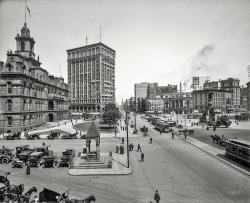
- Splashdown: 1904
- Ecorse, Michigan. November 1904. "Steamer Detroit , Michigan Central Transfer. The launch." 8x10 glass negative, Detroit Publishing ... Posted by Dave - 08/21/2012 - 1:21pm -

- Dime Bank: 1911
- Detroit, Michigan, circa 1911. "Dime Savings Bank building under construction." 8x10 ... Posted by Dave - 07/29/2012 - 10:14am -
![Dime Bank: 1911 Detroit, Michigan, circa 1911. "Dime Savings Bank building under construction." 8x10 inch dry plate glass negative, Detroit Publishing Company. View full size.
CompetitionLooks like the crew on the left has a one story lead over the crew on the right.
The ornate rooftop at lower left was Detroit's old City Hall, demolished in 1961. But the Dime Building is still there. Happy centennial, Dime.
Current LookThe beautiful Penobscot building replaced the smaller building on the far left of the photo 15 years later, sitting nicely next to the tallest building on the left edge of the photo, the Ford Building.
View Larger Map
MaterialsHard to imagine that everything on that building was hauled there by horse teams and freight wagons! Sure would like to see some SHORPY photos of that procedure.
[Don't forget trucks. By 1910 there were thousands of motor trucks and electric trucks on the roads. Below, an ad from 1911. - Dave]
Working the steelI'm not sure if I could handle working on those stage platforms like those guys that are cladding the structure.
What is the process here? Is it concrete, brick or some other rendering over the steel.
It sure is a handsome building.
ConstructionThe steel insides don't seem all that different from contemporary construction, but it's shocking to see the lower unfinished levels - airy and open with all that massive (granite?) density above. With older buildings I tend to believe the that the external skin is structural even if I know better and this messes with that illusion.
Margaret Bourke-White (1904-1971)Would have been only seven years old in this year, but I'm sure this vista would have inspired her immensely. Her late 30's Chrysler Building gargoyle picture still gives me vertigo!
(The Gallery, Detroit Photos, DPC)](https://www.shorpy.com/files/images/4a24411a.thumbnail.jpg)
- Motown Riviera: 1906
- ... The Detroit River circa 1906. "Detroit Oak Belting Co. and Michigan Stove Works." 8x10 inch dry plate glass negative, Detroit Publishing ... Posted by Dave - 09/12/2016 - 11:19am -
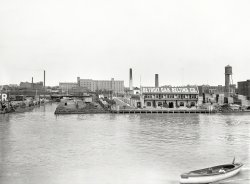
- The Stove Factory: 1901
- Chelsea, Michigan, circa 1901. "Glazier Stove Co., view in yard." It's been ages since ... I couldn't resist.
Chelsea - a Jiffy town Chelsea, Michigan apparently never went without heat in the winter - nor did it probably ... Posted by Dave - 10/20/2012 - 10:51am -
![The Stove Factory: 1901 Chelsea, Michigan, circa 1901. "Glazier Stove Co., view in yard." It's been ages since we checked in at the stove works. Detroit Publishing Co. View full size.
FirewoodThere seems to be an awful lot of wood around there for a Stove Factory. Packing crates perhaps?
[See below. - Dave]
Making wood stovesout of wood ??!!
Got Wood?I'm guessing the boards on the rail car will become shipping crates for the stoves.
Single-useThey must be making "wood stoves."
Sorry I couldn't resist.
Chelsea - a Jiffy townChelsea, Michigan apparently never went without heat in the winter - nor did it probably lack for muffins, as it is to this day the home of "Jiffy" muffin mix, put up in those cute little boxes and sold the world around. Did Detroit Publishing Company's camera man point his box toward that venerable plant while in Chelsea?
Coal bunkerLooks like they are storing coal in the building to the left and it is spilling out of what were once windows.
Great view of the brake pipe hose, glad hand and coupler on that old rail car!
EfficiencyThis company was both quite efficient and attentive to their customers's needs. Not only did you get a new stove, you also got the makings for the first fire you'd start in it.
(The Gallery, DPC, Glazier Stove Works, Railroads)](https://www.shorpy.com/files/images/4a20455a.thumbnail.jpg)
- Home, James: 1910
- Grosse Pointe, Michigan, circa 1910. "F.M. Alger residence." The home of banker-industrialist ... he rose to become a Brevet Major General, Governor of Michigan, U.S. Senator, and Secretary of War. In his spare time, he made a ... Posted by Dave - 10/24/2020 - 2:12pm -
![Home, James: 1910 Grosse Pointe, Michigan, circa 1910. "F.M. Alger residence." The home of banker-industrialist Frederick Moulton Alger. 8x10 inch glass negative, Detroit Publishing Company. View full size.
A story of three Freds (and a Frances)To the right of Fred, and between the two pooches, are Miss Francis Alger and Master Fred Alger Jr.. Fred Jr., like his father, would enter politics, ultimately serving as an Ambassador to Belgium during the Eisenhower Administration. His two sons - Fred Alger and David Dewey Alger - were the first and second CEOs of Fred Alger Management, a fund investment firm with principal offices on the 93rd floor of the World Trade Center. The September 11 attacks killed David and most of the firm's analysts, but Fred (who had moved to Switzerland) returned to rebuild the company.
https://www.alger.com/AlgerDocuments/Money_ReincarnationofFredAlger.pdf
The oldest Fred served in the Army in the Spanish-American War and World War I. In World War II, Frances served in the Red Cross and Fred Jr. served in the Navy. His son Fred served in the Marines.
Before the Three FredsThe father of Fred the First was Russell Alexander Alger (1836–1907). Orphaned at 13, he worked on a farm to support his younger siblings. From those humble origins, he rose to become a Brevet Major General, Governor of Michigan, U.S. Senator, and Secretary of War. In his spare time, he made a fortune in lumber and railroads.
No longer thereLost to development in the 1960s.
https://www.higbiemaxon.com/blog/historical-architecture-of-grosse-point...
Fred's ChauffeurAs the title suggests, I don't think that's the elder Fred at the left of the photo. The gentleman is wearing the proper attire of a professional driver, and perhaps he's getting ready to take the car out of the garage for a trip (but first taking a few moments to play with the dogs/kids and pose for the photographer).
Are these really the Alger children?Frances would have been about six (born 1904) while Frederick (born 1907) would have been about three. The children in the photo are almost exactly opposites of what I expected.
[We're not sure who they are or when the photo was taken. But probably 1910 or earlier based on the license plates. - Dave]
(The Gallery, Detroit Photos, Dogs, DPC, Kids)](https://www.shorpy.com/files/images/SHORPY-4a22543a.thumbnail.jpg)
- Slider: 1910
- ... 14, 1910. "Detroit Shipbuilding Co. yards at Wyandotte, Michigan. Launch of bulk steel carrier E.H. Utley ." 8x10 inch glass ... Posted by Dave - 08/20/2012 - 4:21pm -
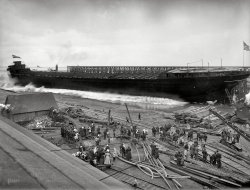
- Tennessee Club: 1906
- ... Curved dash Oldsmobile. Built in my home town, Lansing Michigan.
A few more manhole covers please One every 5 feet or so?
... Posted by Dave - 05/29/2014 - 7:46am -
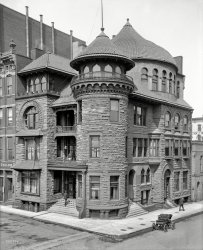
- Grand Circus Park: 1908
- ... from the circle is the Governor Bagley house, later the Michigan Conservatory of Music, previously featured on Shorpy .
Current ... as a face for a future building. Like much of downtown Detroit, it is marred by the unsightly People Mover elevated rail which ... Posted by Dave - 11/19/2014 - 11:55am -
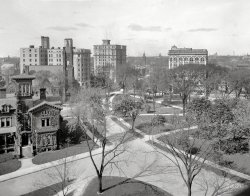
- A Chorus Line: 1905
- ... "ore docks."
The system was introduced at Marquette, Michigan. Ore was delivered to the top of the dock, and dumped into large ... the hand shoveling.
Lakes boats didn't come home to Michigan empty, they typically backhauled coal, which was also loaded by ... Posted by Dave - 07/30/2012 - 11:16pm -
![A Chorus Line: 1905 Lake Erie circa 1905. "Hulett clamshell hoists, Cleveland, Ohio." 8x10 inch dry plate glass negative, Detroit Publishing Company. View full size.
Nine men......one must look hard to find most of them.
Count the PeopleI stopped counting at eight people, upon encountering an additional one that I couldn't tell about.
Two guys with great proprioceptionAnd they give you a sense of the huge size of this processing plant. I wonder how many men got injured falling off the hoists, working up there in various drenching conditions?
How exactly did these hoists work? They would lift up nets or pallets full of oysters, which would then be trundled out by conveyor belt? The din and smell of a fleet of ten boats unloading at one time must have been stupefying. Do you have any shots of this plant at work?
[Clamshell hoists don't have anything to do with oysters, clams, or seafood in general. They're for loading iron ore. - Dave]
I count 11if you include "the Shadow".
ClamshellsTechnically, clamshell hoists are so named because they (somewhat) resemble and open and close similarly to the bivalves' shells.
Brown Fast PlantsTracking down the historical/technical details of this photo was complicated because the internetz are full of information on its more famous kin: the still-standing Hulett Ore Unloaders.
Nonetheless, the best information on the pictured machinery is in the 1905 book, "Brownhoist": Patent Automatic Hoisting and Conveying Appliances. Pages 43 & 44 have alternate views of the same equipment.
Briefly: The location is the Cleveland & Pittsburgh Dock of the Pennsylvania railroad. This type of hoist, designed by Alexander Brown, was known as a "fast plant" and was used to unload ore from a ship and transfer it to waiting rail cars. The specimens here were all steam-powered but later models used electricity. The unloading arm of the hoists spanned 5 to 7 railroad tracks and could load fifty rail cars without shifting. The business end of the hoists were equipped with Hulett clamshells and Andrews scrapers.
Hulett ClamshellsThese are Brown rigs with Hulett clamshells, as noted in the caption, for transferring ore onto railcars from ships called ore carriers.
I count 11 alsoI also count 11 including the man bent over behind the crane rails near the steam vent and the 3 atop the rail cars
What's up dock?Since 1858, gravity has been used to load ore boats (naval tradition notwithstanding, all bulk carriers are "boats" on the Great Lakes) from structures properly known as "ore docks."
The system was introduced at Marquette, Michigan. Ore was delivered to the top of the dock, and dumped into large holding pockets, each fitted with a side discharge chute. Brigantine-rigged (no boom between masts) Schooners were the favorite for ore shipments. They came alongside and typically loaded ore directly on deck, roughly 300 tons per trip — which could take four or more days to offload by hand on arrival, longer if it was loaded in the holds below deck
As demand for ore skyrocketed, deck hatches were cut into these vessels to increase capacity. The first bulk freighter (the R.J. Hackett) was purpose-built for the iron ore trade in 1869. These bigger vessels opened the floodgates to a variety of mechanical unloaders mentioned in the earlier post, but the Brown and Hulett machines emerged as the leaders.
A Brown bucket held roughly 1-1/2 tons, but the machine could only lower and raise the bucket straight into the hold, where it still had to be filled by hand; fitting the machine shown with clamshells should have greatly improved its efficiency.
The first Hulett bucket held 10 tons (later models could handle up to 22 tons per bite), but its greatest advantage was its mobility, as it could move up & down, left & right and forward/reverse within the hold, greatly reducing the hand shoveling.
Lakes boats didn't come home to Michigan empty, they typically backhauled coal, which was also loaded by gravity.
(The Gallery, Boats & Bridges, Cleveland, DPC, Railroads)](https://www.shorpy.com/files/images/4a11185a.thumbnail.jpg)
- Le Bel Âge: 1908
- Detroit, Michigan, circa 1908. "Crowd at Belle Isle Park casino." 8x10 inch dry plate ... of the interior that I should post. I no longer live in Detroit, but I believe the replacement casino got a big update a few years ago. ... Posted by Dave - 02/09/2019 - 4:28pm -
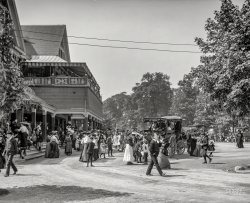
- Give Him a Schick: 1941
- July 1941. "Detroit, Michigan. Men's toilet accessories department at the Crowley-Milner department ... Posted by Dave - 01/09/2013 - 4:29pm -
![Give Him a Schick: 1941 July 1941. "Detroit, Michigan. Men's toilet accessories department at the Crowley-Milner department store." Inspecting the Schick Shaver. Large-format nitrate negative by Arthur Siegel for the Office of War Information. View full size.
Am I reading this correctlySoda-Mizer - - It Seals- - It Saves - - It Syphons. SODA MIZER, really, just don't say it too fast.
WowThat little Schick shaver retails for an inflation-adjusted $226.
Crowley's and Hudson'sIt's very nostalgic for me to see all of these pictures of Crowley-Milner that you've been posting recently. This department store, known by generations of Detroiters as "Crowley's," is still fondly remembered by people of a certain age for the big wooden escalators that clacked loudly up the center of the store until its closing day in 1977. But, even though many people preferred to shop there, Crowley's always played second fiddle to its larger arch-rival and neighbor, the J.L. Hudson Co., or "Hudson's".
My great aunt worked for many years at a cosmetics counter that must've been within sight of the men's toiletries counter shown in this photo. But her older sister, my grandmother, worked in the cosmetics department of Hudson's, and would lord Hudson's greater size, fame, class, and sales volume over her poor sibling at holiday parties. Such was the rivalry between the stores - and the sisters - that we were strictly instructed on our trips downtown never to mention to either one of them if we had just visited the other at her cosmetics counter.
Was a pharmacist required?The salesman is dressed like a pharmacist. Did they need a license to sell brushes, toothpaste an soda mizers in those days?
Ya reckonthe folks at Kolynos paid JD Salinger to plug their product in “The Catcher in the Rye?” Holdon Caulfield laments that "Everybody was asleep or out or home for the week end, and it was very, very quiet and depressing in the corridor. There was this empty box of Kolynos toothpaste outside Leahy and Hoffman's door, and while I walked down towards the stairs, I kept giving it a boot with this sheep-lined slipper I had on." Holdon, birthed in 1951, would have been a couple years shy of knowing the joys of chlorophyll laced Kolynos.
["Holdon" -- really? - Dave]
Salinger was smarter than thatHoldon [sic], birthed in 1951, would have been a couple years shy of knowing the joys of chlorophyll laced Kolynos.
While the book came out in 1951, with a contemporary setting, Holden was supposed to be 16 years old. With a 1934-35 birthdate he would have been old enough to have enjoyed Kolynos.
[Especially since it would already have been an established brand at the time of his birth. The chlorophyll version, not mentioned in the novel, was not marketed until 1952. - tterrace]
Hold on, everybody!It wasn't only Holden Caulfield who did product placement for Kolynos. Salman Rushdie's book "Midnight Children" has a chapter, "The Kolynos Kid" and Cyril McNeile, who created Bulldog Drummond, wrote a 1922 novel, "The Black Gang", in which this can be found: "By the way, my boy, you skimped your teeth pretty badly to-night. You'll have to do better to-morrow. Most of your molars must be sitting up and begging for Kolynos if that's your normal effort."
The brand name dates back to 1908 and was a top U.S. dental care company in the 1930s and 1940s, sponsoring big time radio programs such as "Mr. Keen, Tracer of Lost Persons", "The Adventures of Ellery Queen" and "Our Gal Sunday". Not a reality show among them. Kolynos was bought by Colgate-Palmolive in 1995 and is a leading brand in Latin and South America.
Pro-phy-lac-ticBefore we get too carried away, I'll point out that the Pro-phy-lac-tic Brush Company of Florence, Mass. was a manufacturer of... yes, brushes, notably tooth but also hair and grooming. However, I did spot a non-PC accessory - though not one of their products:
Soda-what?Yeah, the soda thing caught my eye too. Either a dreadful oversight by the marketing department or some kind of joke.
How to Make the Most of a Bottleneck!
Life, May 12, 1941.](https://www.shorpy.com/files/images/SHORPY_8d25334a.thumbnail.jpg)
- The Grayhouse: 1907
- ... procedings of the City of Detroit going on, the State of Michigan has acquired ownership of the entire island including all upon it. ... of the Anna Scripps Whitcomb Conservatory on Belle Isle, Detroit, Michigan, April 1956. Scanned Kodachrome slide.
View ... Posted by Dave - 03/21/2014 - 11:35am -

- Overturned: 1921
- ... on the radiator is actually "THE DUPLEX LIMITED."
The Michigan State University Archives & Historical Collection states, "The ... Posted by Dave - 08/12/2011 - 9:15am -
![Overturned: 1921 1921. "Washington Rapid Transit Co. wreck." More vehicular mayhem in the nation's capital. National Photo Company glass negative. View full size.
Heated StairsLooks like the extra exhaust plumbing goes into the stairs. Probably to keep the ice off of them. There are holes in the bottom of the steps to let the exhaust fumes escape.
PlumbingThat's an interesting assemblage of pipes on the right side of the vehicle from just in front of what appears to be a muffler. The cleanliness of the underside makes me think the vehicle hasn't been in service long.
The extra pipeI see what appears to be an exhaust pipe coming from the engine and going into the muffler.
What is the pipe that looks to be tee'd off of the exhaust, prior to the muffler, running to the area behind what are probably steps to get into the driver's seat?
[The driver's seat is on the other side. The steps are for the passenger entrance. - Dave]
Re: The extra pipeI hate to think it's a heater feed, but that's all that comes to mind!
External plumbingVery clean undercarriage. Interesting plumbing on the exhaust, very curious.
Heater Pipe?I've seen asphalt trucks run their exhaust into the cargo area to keep hot stuff from freezing in winter. Judging from the way the spectators are dressed it was cold that day. Wondering if this wasn't some form of heater.
The mufflerIt seems to be a closed tank. Perhaps it is tuned to reflect the exhaust pulses 180 degrees out of phase to muffle the sound.
Heat for interior radiatorJust a guess: the piping appears to be too heavy a gauge for exhaust fumes. Perhaps it conveys water to a radiator within the interior, and located by the exit, where the cold air enters the bus.
JanusThis section is my favorite in the entire photo:
Here's Your ProblemYou don't have any front brakes. This thing pretty much has the suspension of a covered wagon and a two ton tank engine.
Slippery When WetThe undercarriage is incredibly clean, especially considering the condition of roads (and occasional lack thereof) at that time. It's like someone took it out for a test drive right of the dealer's lot! "Yeah, I don't think I'll take this one -- it feels a little lopsided."
Okehed Transportation
Advertisement, Washington Post, Sep 26, 1921.
Washington Motor Bus System
Comparatively few people are as familiar as they should be with the very marked and singular success of the Washington Motor Bus System.
So we wish to give you some of the plain, honest facts about the way all Washington has okehed this most convenient, safe and practical means of transportation.
Yet, in pointing out the success of the motor bus system, we do not for one minute wish to convey the idea that the motor bus is going to supersede the street car. No, indeed. The street car has its place, and a mighty important one. So has the modern; properly organized and efficiently managed line of the motor buses!
But we do wish to let Washington know what only a part of it already knows — that is, the Washington Rapid Transit System has become a prominent factor in the daily transportation of tens of thousands of Washington folks.
This Motor bus system was started only six months ago! Yet in that short time it carried over three-quarters of a million passengers, and mind you, this was when Washington was comparatively empty.
How many of you have stopped to realize what enormous profits there are in a properly organized, efficiently managed municipal motor bus system? For example, are you familiar with the facts in connection with London, New York, Detroit and Chicago? In London, even during the war, they paid over a million dollars a year in dividends. New York is the best "at home" example we have. Here they have carried over 40,000,000 passengers a year.
…
Less than six months ago the first properly organized and efficiently managed system of motor buses was introduced to Washington. The first installation consisted of a fleet of ten motor buses, and they operated on Sixteenth street northwest. So popular were they with the public that April 20th we had to put for new buses on!
…
So insistent has the demand been for more buses and additional routes that we have decided to expand the system, and will install sixteen brand-new buses. Ten will go into operation during the next three weeks, the balance soon after the first of November.
On account of the growing popularity of this splendid motor bus service, the Federal Utilities Commission has granted us two new franchises, which require the installation of these additional buses,
First route, starting from Eighth and Pennsylvania to Twelfth street, to Massachusetts avenue, to Sixteenth street northwest, to Harvard street, to Thirteenth street, to Park road, to New Hampshire avenue, to Grant Circle, and return (Petworth Division).
Second route, starting at Eighth and Pennsylvania avenue, to Twelfth, to Rhode Island avenue, to North Capitol street, and return.
…
Washington Rapid Transit Company
Fourteenth and Buchanan Streets N.W.
Telephone — Columbia 4026
In 1933, Washington Rapid Transit merged with the Capital Traction Company and Washington Railway and Electric Company to form the Capital Transit Company. Route Map of Washington Rapid Transit Company with examples of double-deck and single-deck buses operated by WRT, "Fare 10 Cents" (via):
16th and VLooks like the apartments at 16th and V Street NW. 16th and U is still a pretty treacherous intersection.
View Larger Map
The Line UpBelow are a photo of the new buses lined up from a Library of Congress photo, and a close-up of bus Number 2.
"Built For Business"I turned the original photo from the LOC sideways and it is possible to read, "THE DUPLEX," at the top of the radiator: Another picture from the LOC shows that the entire set of words on the radiator is actually "THE DUPLEX LIMITED."
The Michigan State University Archives & Historical Collection states, "The Duplex Power Car Company was founded in 1909 and produced mostly trucks and truck related machinery until it was reorganized into the Duplex Truck Company in 1916. The Duplex Truck Company was a prominent builder and supplier of trucks to private companies as well as government agencies during the years between 1916 and 1955. In 1955 Warner and Swasey Company purchased the Duplex Truck Company and the Duplex division closed in 1975."
A picture of a Duplex radiator, their logo, and a truck, all from another LOC photo, are below.
Overturned by Big TruckThe Evening Star (Washington, D.C.) of March 10, 1921, page 12, details the accident that is shown in the photo. The Washington Herald, on the same date, page 1, states the ambulance on the way to the accident scene was also involved in a mishap. The full Evening Star article and an extract from the Washington Herald story are below.
Other information found confirms that the Washington Rapid Transit Company purchased 20 chassis and bus bodies from William P. Killeen who was the Duplex Power Company (truck) distributor for the D.C. area. Service with these buses began on March 1, 1921 which is probably why the bottom of the bus is in such good condition. The bus fare was eight cents on the route.
(The Gallery, Cars, Trucks, Buses, D.C., Natl Photo)](https://www.shorpy.com/files/images/29920u.thumbnail.jpg)
- The Oyster Wagon: 1905
- ... form of illegal enterprise. As a merchant sailor from Michigan, my mother's father, according to stories he told his children, was ... Posted by Dave - 08/13/2012 - 7:27pm -
![The Oyster Wagon: 1905 Circa 1905. "Unloading oyster luggers at Baltimore." 8x10 inch dry plate glass negative, Detroit Publishing Company. View full size.
Bowlerstache"No man shall wear a bowler hat in public unless he is festooned with moustache." Baltimore Public Ordinance 23 of 1902.
Arlo Guthrie?The guy in the front of the picture looks like a young Arlo Guthrie. I've heard of Alice's Restaurant, but Alice's Oyster Bar?
[I think it's Richard E. Grant. - tterrace]
Those were the days,when oysters were the food of the masses.
Pirates of the Chesapeake???Back in those days, nighttime rustling of oysters out in the Bay from beds planted by commecial interests was a popular form of illegal enterprise. As a merchant sailor from Michigan, my mother's father, according to stories he told his children, was part of that trade. The oyster policew were hot on his trail by 1890, so he fled north to New York State and became an insurance man and real estate operator...somewhat of a less exciting job. This is a terrific photo.
Wilse
Keaton?I think the guy front center looks like Buster Keaton. He has the right hat anyway.
Also, front right is a telegraph boy. We have seen many pictures of child laborers with the photographer's seeming disapproval. What did telegraph boys grow up to do for work?
$1 per bushelWhoever captioned this photo for the Detroit Publishing Co. did not know their boats. While luggers were common in the Gulf Coast oyster fisheries, on the Chesapeake the dredgers sailed in bugeyes, pungies and skipjacks. The location of the photo is Pratt street; in the background is Pier 1 and the Maryland Lime and Cement Co.
Baltimore Sun, January 10, 1903.
Many Oysters Brought In
At Least 30,000 Bushels Arrive and More Coming.
Fifty sailing vessels deeply laden with oysters anchored in the harbor Thursday. It is estimated they contain at least 30,000 bushels of oysters, representing a value of $30,000 or more. Another large fleet is reported bound up from the lower bay, and some of the captains who have had experience in such matters said yesterday that a glut may ensue.
Yesterday along the wharves oysters were selling at prices ranging from 80 cents to $1.25 per bushel, according to size, quality and flavor. The demand was not unusually brisk, even for selects, and many captains who arrived early yesterday morning went to bed last night with their cargoes still unsold. Many of the vessels were consigned directly to the packing houses or are running under charter. Many other captains, however, depend solely on the market to dispose of their stock. Among some of these there was a feeling of uneasiness as the fleet continued to grow during the day.
At 4 o'clock yesterday afternoon there were 27 deeply laden oysters freighters in Canton Hollow or tied up along the Canton docks, discharging. At Pratt street, between Bowley's wharf and Light street, 23 loaded craft were tied up waiting to unload. Capt. Allen P. Vane, of the schooner Margaret H. Vane, which arrived Tuesday, said yesterday that he passed a large fleet of loaded oyster boats in the lower bay, bound for this port. They were expected to arrive this morning, as the southwest wind must have brought them hurrying up the bay yesterday afternoon.
The quantity of oysters now in port exceeds by far any previous day's record since the opening of the present season. Most of them are of fair quality from the York, Putuxent and Rappahannock rivers and from the Western Shore of the bay. Some are from Tangier and are very large. Very few are from the Eastern Shore of Maryland. The packing houses there are said to be using all the stock taken in those waters. Practically no oysters are coming from the upper bay and the present season there is said to be a failure. Local packing houses are running with full forces and have no difficulty in securing working stock. The $1.25 quotations yesterday were for select stock from the rocks which can be utilized as barrel stock. The prevailing prices hovered about $1.
Shucks!What you say when your oyster wagon tips over...
Skipjacks and Buy BoatsThe boats with the masts raked sharply back are skipjacks and bugeys. They would dredge for oysters. Early bugeyes were made from hollowed out logs, like big canoes. The more modern skipjacks appeared late in the 19th century.
Buy boats would go around and buy oysters directly from watermen at work on the bay and bring them into Baltimore and other ports to resell. The boats with the more vertical masts are likely buy boats, called luggers, I suppose, in different locales.
A sharply raked mast is an advantage when pulling a dredge, but otherwise makes for difficult sailing.
Here is a photo of a working skipjack or two that my father took at the Annapolis City Dock in October 1965. The Dock was full of working skipjacks at that time.
A banana and oyster sandwichIn the distance is the USS Constellation moored at Pier One Pratt Street today. This is also the same area where Bananas to Baltimore was featured a while back on these pages.
Dirty waterI always thought that the water would have been clean, but I daresay, it looked worse then!
Oyster warsThe last person killed over oysters was in the 1950's. There are two excellent books about oystering and the attendant violence. "The Oyster Wars" by David Faulkner and "The Oyster Wars of the Chesapeake Bay" by John Wennersten.
(If you're interested.)
http://www.amazon.com/Oyster-Wars-David-Faulkner/dp/1601455313
http://www.amazon.com/Oyster-Wars-Chesapeake-Bay/dp/061518250X
(The Gallery, Baltimore, Boats & Bridges, DPC)](https://www.shorpy.com/files/images/SHORPY_4a12585a.thumbnail.jpg)
- The Car Factory: 1911
- ... Detroit’s landscape.
License on the radiator Michigan started with official license plates in 1910. From 1905-1910 the auto ... Posted by Dave - 09/28/2014 - 4:36pm -
![The Car Factory: 1911 Detroit circa 1911. "Boulevard view, Packard auto plant." At least two laborers are hard at work in our second look at the expansion of Albert Kahn's factory from two stories to four, at the spot where a bridge was eventually built over Grand Boulevard, connecting this building with one across the street. View full size.
Interesting PlateIt looks like the license plate number was painted on the radiator of that car. Was this a common practice?
[Or "license number," since there is no plate. - Dave]
Bryant and Detwiler Contractor There can be no question that Albert Kahn, John Bryant and Ward Detwiler (Bryant and Detwiler Contractors, Detroit) helped shape the greatness Detroit had achieved at its peak. Arguably, Kahn and Bryant/Detwiler were a team: Kahn would design and Bryant /Detwiler would build many of the great buildings that once graced Detroit’s landscape.
License on the radiatorMichigan started with official license plates in 1910. From 1905-1910 the auto owner had to provide his own plates based on a number assigned by the state. This motorist opted to paint his number in bold and sloppy lettering across the radiator. Not classy, but legal. So this photo has to be earlier than 1911. Want to know more, visit www.LeatherLicensePlates.com
Packard plant todayhttp://www.youtube.com/watch?v=hvTwY6tPf4k
A youtube link to a drone tour through the remains, with a MoTown tune to view by.
It pains me bad to think that one of America's finest autos used to roll out of there, and today it looks like a bombed-out 35 acre war zone.
What I wouldnt give to see it operating in its heyday.
The look of industrial AmericaThis plant is so typical of industrial buildings in the first half of the 20'th century, reinforced concrete columns and floors with wall gaps filled in with brick or glass. They were efficient in the use of steel, trading low steel use for high labor costs for forming, pouring, stripping, etc.
This style of construction was especially appropriate for WWII factories when steel was needed by the war effort and concrete and brick were more readily available.
As structural steel became less expensive and more plentiful and labor costs increased for the forming and pouring over the years, structural steel structures with steel curtain walls replaced this style of building in America in the 1950's. The style continued on much longer in Europe and the Eastern Block.
Today it is very rare to see a new cast in place reinforced concrete building in America.
Kahn's work was not limited to rectangular layout factories like the Packard plant. He was also very capable of designing "people" buildings that were functional and very good looking.
(The Gallery, Cars, Trucks, Buses, Detroit Photos, DPC, Factories)](https://www.shorpy.com/files/images/SHORPY-4a21336a.thumbnail.jpg)
- Iron Ore on Erie: 1900
- Circa 1900. "Lake Shore & Michigan Southern Railway ore docks, Ashtabula, Ohio." 8x10 inch glass ... in one scoop.
D for dedicated The Lake Shore & Michigan Southern gondolas have the letter D prefacing the car number. This ... Posted by Dave - 06/25/2016 - 10:09am -
![Iron Ore on Erie: 1900 Circa 1900. "Lake Shore & Michigan Southern Railway ore docks, Ashtabula, Ohio." 8x10 inch glass negative, Detroit Publishing Company. View full size.
Clean, but ...Am struck by how clean this busy site seems to be. Of course, those massive piles of iron ore are a rust-red color and that tint might prevail all across the scene. A really fine steel industry shot. Glad you put it up.
Cranes?How did those Crane like thingies in the background work?
When You're Out of Schlitz ...That little Schlitz private owner refrigerator car was the prototype for one of the most popular Walther kits for kids like me, whose parents could only afford a Marx 027 set. At 36ft long in real life, it scaled down small enough to go around the 027 curves, and still let an impecunious kid build a "proper" piece of model rolling stock. I still have mine.
I'm often reminded of painters and paintings on this site. Today it's Charles Sheeler, particularly the smaller sized version.
[Tiny Charles Sheeler is one of my favorites, too. - Dave]
"Cranes"I think those are actually movable sets of elevators/conveyor belts. They transfer the material (coal) from one side and then dump it into the piles you see. They move side-to-side (into and out of the page in this picture) to service different parts of the yard. I think there are elevators/bucket lifts on the input side that puts the material on the belts which climb then the stuff falls off the free end.
Still thereThe docks are still there, with ore trains and big piles of ore. Only the equipment has disappeared. I imagine that a modern loader can move a third of a carload in one scoop.
D for dedicatedThe Lake Shore & Michigan Southern gondolas have the letter D prefacing the car number. This told car checkers the car was in dedicated service so not to be taken off its current route. In this case mine to pier to steel mill over and over again.
The ore bridges were a step up from the whirley cranes but soon have competition from massive Hullet unloaders with their grasshopper-like dipping legs.
The ground looks clean since this was an area where only the most foolish non-railroader would tread and drop trash. There is little in this photo that a safety inspector would praise. Those crib retaining walls being a first concern.
Short-lived lighthouseThe lighthouse at the left side of the picture dates this to between 1897 and 1904, the latter date when these facilities were doubled in size and a whole new terminal was built for the Pennsy. It served as the rear light of pair to guide ships into the harbor. With the expansion a new tower was built in the new section, and that was all she wrote for this one.
More "Cranes"Those structures do not have conveyor belts - if you look closely, you can see a few of the buckets at various distances from the ship. There are small 'trolleys' which move along the bridge-like structures, one on each. Each trolley caries a bucket (probably clamshell) which can reach into the ship's hold, remove some ore (or coal, but I suspect ore), raise it up, and then move either over the large piles, or over railroad cars to dump the load.
Rebuilds...The hopper cars on the far right look to be rebuilds from earlier composite hoppers. Composite types had metal frames, and wooden sides with metal bracing. These cars, however, look to be of an all metal construction. While not overly common in 1900, all metal construction hoppers were starting to come into use. The cars had a longer life span than the wooden composite types, and actually ended up being cheaper to operate in the grand scheme of things.
(The Gallery, Boats & Bridges, DPC, Mining, Railroads)](https://www.shorpy.com/files/images/SHORPY-4a08380a1.thumbnail.jpg)
- The Accident, Part 2
- November 12, 1906. "Accident at Michigan Central R.R. depot, Detroit." 8x10 inch dry plate glass negative, ... Posted by Dave - 09/13/2011 - 7:11pm -
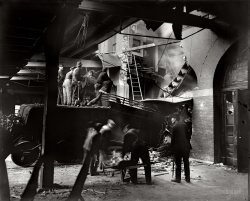
- The Commuter: 1910
- Ann Arbor, Michigan, circa 1910. "Michigan Central railroad station." 8x10 inch dry plate glass negative, Detroit ... Posted by Dave - 08/21/2012 - 4:51pm -
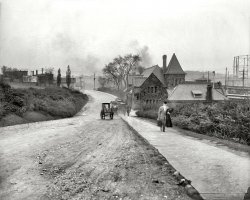
- Gratiot Light: 1901
- Circa 1901. "Gratiot Light, Port Huron, Michigan." A great lighthouse on a Great Lake! 8x10 inch glass negative, ...
Just upstream from the Blue Water Bridge between Michigan and Canada.
Bucolic Heavy woolens, aside it looks like a ... porch of the Grand Hotel.
Gratiot Pronounced in Michigan as GRA-shut, with the 'a' as in grass.
What a tease To stand so ... Posted by Dave - 02/10/2016 - 2:40pm -
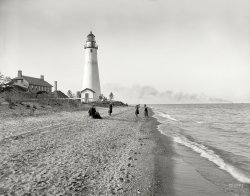
- Something Wicker: 1912
- Detroit, Michigan, circa 1912. "Pringle Furniture Co. -- chairs." 8x10 inch dry plate ... Posted by Dave - 07/29/2012 - 6:09pm -
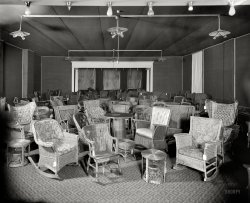
- Castle of Culture: 1899
- Wayne County, Michigan, circa 1899. "Detroit Museum of Art." 8x10 inch dry plate glass ... Posted by Dave - 03/13/2018 - 1:34pm -
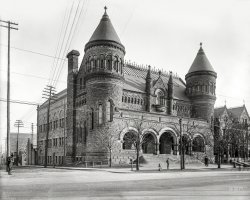
- Ecorse of Course: 1906
- Ecorse, Michigan, circa 1906. "Great Lakes Engineering Works, a portion of the yard." ... Posted by Dave - 07/29/2012 - 1:27pm -
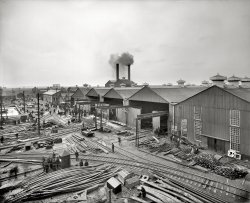
- These Trees: 1910
- St. Clair Flats, Michigan, circa 1910. "Willow Avenue, Star Island." 8x10 inch dry plate glass ... the border with Canada near Harsens Island and Algonac, Michigan.
I found this image at the web site for the Harsens Island ... Posted by Dave - 08/08/2012 - 2:01pm -
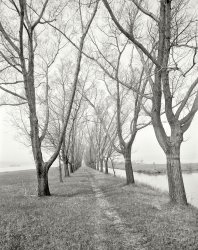
- Going Up: 1911
- Detroit, Michigan, circa 1911. "Dime Savings Bank building under construction." 8x10 ... Posted by Dave - 08/02/2012 - 10:05pm -
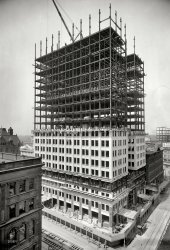
- Summertime: 1900
- Circa 1900. Our next stop in Grosse Ile, Michigan: "Cabin at Rio Vista." 8x10 inch dry plate glass negative, Detroit ... like something out of Dogpatch.
Ahhhh Southern Michigan Summertime!
What's on the window sill? It looks like a toy ... Posted by Dave - 08/20/2012 - 3:50pm -
![Summertime: 1900 Circa 1900. Our next stop in Grosse Ile, Michigan: "Cabin at Rio Vista." 8x10 inch dry plate glass negative, Detroit Publishing Company. View full size.
SpeculationThe boys are just a mite too well dressed to be sharecroppers. Dad probably owns the farm and they and the dog are taking advantage of a photo op with a then 150 year old cabin (give or take a decade).
Li'l Abner slept hereHoo-wee! That house looks like something out of Dogpatch.
AhhhhSouthern Michigan Summertime!
What's on the window sill?It looks like a toy dinosaur. Did they even have those back then?
[It's a Leafosaurus. - Dave]
Potatoes, as far as I can tell.Spaced a bit too far apart in the row, but it's easier to hack weeds that way. Growing a winter supply of spuds by hand is tough, but the option is serious hunger.
"Local Food" people, of which I am one -- I also grow organic veggies for a living -- should remember how scarce and weakly nourishing a truly local food supply can be if that's all you have.
Leafosaurus on the windowsill?Sure looks like a cat to me!
One vote for LeafosaurusDefinitely some Virginia creeper leaves.
(The Gallery, Dogs, DPC, Grosse Ile, Kids)](https://www.shorpy.com/files/images/4a20547a.thumbnail.jpg)
- Fast Fraight: 1906
- Ecorse, Michigan, circa 1906. "Great Lakes Engineering Works." Our title comes from the ... next to the barrels, no plates are visible. In 1923, Michigan Steel Mill started production (see Ecorse Michigan by Kathy Covert Warnes.)
No gym membership required It's no ... Posted by Dave - 08/25/2017 - 10:54am -
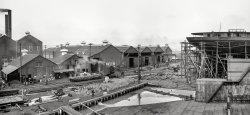
- Edifice Complex: 1901
- Detroit, Michigan, circa 1901. "Wayne County Building." This multi-layered municipal ... Posted by Dave - 05/13/2020 - 9:31pm -
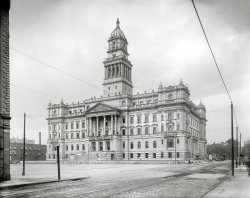
- Mansard Family Values: 1905
- St. Clair, Michigan, circa 1905. "Residences on Front Street." Not for the stair-averse. ... Posted by Dave - 03/08/2022 - 12:48pm -
![Mansard Family Values: 1905 St. Clair, Michigan, circa 1905. "Residences on Front Street." Not for the stair-averse. 8x10 inch dry plate glass negative, Detroit Publishing Company. View full size.
Still ThereThe siblings, minus some of the lofty ornamentation, are both still there, with the one farthest down serving as a bed and breakfast. Also extant is the handsome but plainer frame house next door, a snippet of which is seen on the photo taken from its front lawn.
Later that centuryOr could it be... Disneyland?
It's had some dentil work
MinimalistMansard roofs were all the rage in the 1860s-70s, when these houses certainly were built, but they're a real chore to maintain and went out of fashion by the mid-1880s.
[The Times-Herald newspaper of Port Huron reports that both houses were built by the Mark Hopkins family -- 615 N. Riverside in the late 1880s and 613 (the farther of the two) in 1876. - Dave]
Everything's Up to Date in St. ClairThe neighbors down the way have a smokestack!
Too Tall HandrailIf one figures the rise of the steps are about 7", then that handrail is about 56 inches plus another 36 inches above the first step, or about 7' 6" above the ground. That would be awfully tough for anyone besides an NBA center to hold on to, not to mention a 5'4" woman.
[That's a grille. A handrail would be at an angle, parallel to the stairs. - Dave]
Still a charming community.I "toured" this charming little community yesterday using Google street view. It looks like a peaceful place to live. Houses have been built directly across the street from these old houses, partially spoiling the view of the water from the first floors though I suspect the second floors still have a nice view. The second house is a bed and breakfast called Memories Manor and there are interior pictures on the Street View for the house.
(The Gallery, DPC)](https://www.shorpy.com/files/images/SHORPY-4a12653a.thumbnail.jpg)























